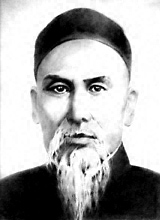 |
| Yang Lu Chan und Gerneral History |

Yang Fu-Kui (1799-1872) or also known as Yang Lu-Chan, was born in Yongnian Hsien, Hebei Province. Born in a poor family, when he was 10, he went to Chenjiagon in Henan province to learn Tai Chi from the famous master Chen Shing Xing (1771-1853). At age 30, he studied the Chen Style of Tai Chi "Lao Jia" (old frame style) about thirty years. Later on, he went to Peking and removed some original movements from the Chen Style, such as "Fa-Jeng" (release of power), vigorous jumping, heavy stepping, and some difficult movements to create Yang Style. Yang Style, suitable for general Tai Chi practitioners and easy to learn, would later become the most popular style of Tai Chi in the world. His third son, Yang Jian (1839-1917) (also known as Jianhou), created "Joun Jia" (middle frame style). Yang Jian-hou's third son, Yang Cheng-Fu (also known as Yang Shao-Ching) created "Dai Jia" (largeframe style) which is different than his uncle Yang Yok's (1837-1892) (also known as Baihou) "Shao Jia (small frame style). Yang Cheng-Fu's "Dai Jia" style is now the most popular style of Tai Chi in the world. Yang Style Tai Chi is created from Chen Style Tai Chi. The speed is steady and movements flow continuously. This is different from Chen Style in which there are sudden slow and quick jerky movements with vigorous force. Yang Style is simple – using Jing (internal power) is like drawing silk from a cocoon. This is much different from Chen Style's twisting and spiraling motions. Yang Style's breathing is natural. The Chi (vital energy stream) is sunk to the lower dantien (the place about one and a half inches below the navel). Chen Style, in contrast, requires both twisting and sinking the chi to the lower dantien. Yang Style practice is simple, neat, and more suitable for all ages and health conditions than many other styles. These are some of the reasons Yang Style is more popular than Chen Style. The thr ee generations of the Yang family's technique was very well know in Peking, China. Since 1928, Yang Cheng-Fu taught in Nianking, Shanghai, Hunchow, Guangchow, Hunhow, and many other areas in China. Yang Cheng-Fu's Dai Jia large frame style, as a result, has spread with amazing popularity thr oughout China. The Yang Style of Tai Chi has a simple structure, yet in some ways, elaborate. Its body posture is centrally balanced – not leaning towards any sides. Its movements are soft, stately, full and round, smooth, with combined soft and hard movements, agile, light and steady. Practice entails transitions from loose to soft, and soft gradually becoming hard, then soft and hard together. Its frame has high, middle, and low stances. Which stance Yang Style practitioners choose to use depends on the age, gender, weaknesses, or strength of the practitioner. Yang Style Tai Chi can also be used for physical therapy, rehabilitation, and faster recovery from sickness. Continued practice adds strength and improvement to the practitioner's technique. Correct Yang Style Tai Chi practice expresses its lordly, majestic, and graceful appearance. Yang Cheng-Fu practiced Tai Chi neatly and elaborately with command. He understood the essential of the rules and the importance of following the rules. Yang Cheng-Fu's Tai Chi form was light, agile, steady, centrally balanced, had round movements, and his movements were hard and soft. It was very apparent that Yang Cheng-Fu was very august. From his postures, it is easy to see that he met the essential requirements for practicing Tai Chi correctly. He has said, " Tai chi is soft meeting hard. It is the art of a needle hidden in the cotton." In fact, this quote is the shadow of Yang Cheng-Fu himself. |
| Copyright © Nancy Haynes Held E-Mail: info@tai-chi-chuan.de |
